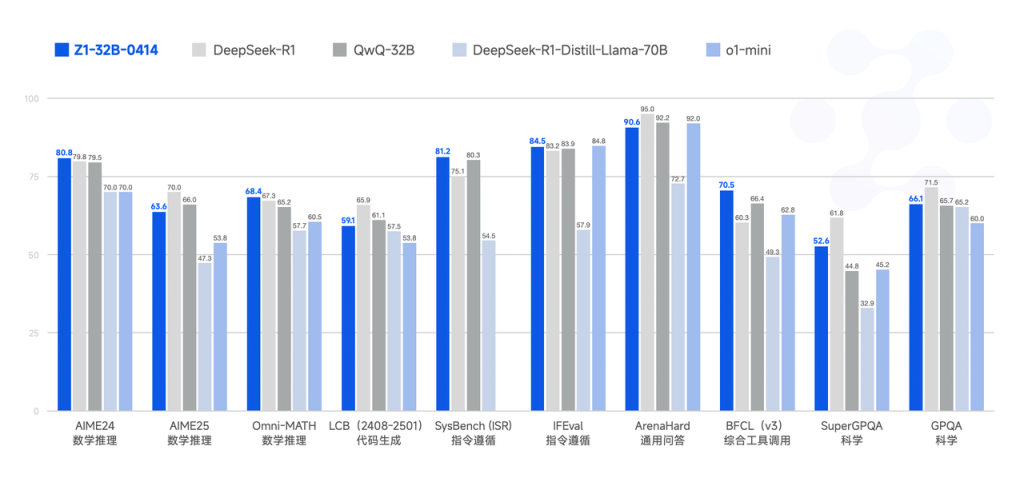THUDM Releases GLM 4: A 32B Parameter Model Competing Head-to-Head with GPT-4o and DeepSeek-V3
In the rapidly evolving landscape of large language models (LLMs), researchers and organizations face significant challenges. These include enhancing reasoning abilities, providing robust multilingual support, and efficiently managing complex, open-ended tasks. Although smaller models are often more accessible and cost-effective, they typically fall short in performance when compared to their larger counterparts. Hence, there is a growing emphasis on developing mid-sized models that effectively balance computational efficiency with strong reasoning and instruction-following capabilities.
The recent release of GLM 4 from Tsinghua University, particularly the GLM-Z1-32B-0414 variant, addresses these challenges effectively. Trained on a substantial dataset of 15 trillion tokens, GLM 4 is designed to offer reliable multilingual capabilities and incorporates innovative reasoning strategies referred to as & mode.&; This release positions GLM 4 alongside other notable models like DeepSeek Distill, QwQ, and O1-mini, and is distributed under the widely respected MIT license. Notably, despite its relatively moderate parameter size of 32 billion, GLM 4 demonstrates performance comparable to much larger models such as GPT-4o and DeepSeek-V3, which contain up to 671 billion parameters, particularly in reasoning-centric benchmarks.
On a technical level, GLM-Z1-32B-0414 leverages extensive high-quality training data, including synthetically generated reasoning tasks, to strengthen analytical capabilities. The model integrates sophisticated techniques such as rejection sampling and reinforcement learning (RL) to improve performance in agent-based tasks, coding, function calling, and search-driven question-answering tasks. Additionally, its & Reasoning Model&; variation further refines this by employing cold-start methods combined with extended RL training, specifically targeted at complex mathematical, logical, and coding tasks. Pairwise ranking feedback mechanisms are employed during training to enhance the model& general reasoning effectiveness.
An advanced variant, GLM-Z1-Rumination-32B-0414, introduces a novel approach termed &; enabling prolonged reflective reasoning for tackling open-ended, complex queries like comparative AI-driven urban analysis. This variant integrates advanced search tools with multi-objective reinforcement learning, significantly enhancing its utility in research-intensive tasks and complex retrieval-based scenarios. Complementing these larger models, the GLM-Z1-9B-0414 version, with its 9 billion parameters, provides strong mathematical and general reasoning capabilities, demonstrating the practicality of smaller-scale models.
Performance data from benchmark evaluations emphasize the strengths of the GLM 4 series. Specifically, GLM-4-32B-0414 shows robust results compared to GPT-4o, DeepSeek-V3, and Qwen2.5-Max across multiple benchmarks. On the IFEval instruction-following benchmark, GLM 4 scores an impressive 87.6. In task automation benchmarks such as TAU-Bench, GLM 4 achieves strong scores in scenarios like retail (68.7) and airline (51.2). For search-augmented question-answering tasks, as evaluated by SimpleQA, the model records a high score of 88.1. Additionally, GLM 4 closely matches GPT-4o’s performance in function-calling tasks evaluated by the BFCL-v3 benchmark, securing an overall score of 69.6. In practical code repair scenarios tested through SWE-bench with the Moatless framework, GLM 4 achieves a success rate of 33.8%, underscoring its practical value.
In summary, GLM 4 presents itself as an effective family of language models, successfully bridging the performance gap between smaller, more accessible models and the traditionally superior larger-scale counterparts. The GLM-Z1 series, especially the 32B variant, exemplifies this balanced approach by providing powerful reasoning capabilities while maintaining computational affordability. With the added advantage of its permissive MIT license, GLM 4 is positioned as a robust tool for research and enterprise applications requiring high-performance AI solutions without the extensive computational overhead traditionally associated with larger models.
Check out and . All credit for this research goes to the researchers of this project. Also, feel free to follow us on and don’t forget to join our .
The post appeared first on .
#ArtificialIntelligence #MachineLearning #AI #DeepLearning #Robotics

